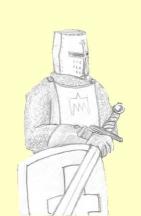 |
||||||
 |
The Ceremony of Knighthood
Becoming a knight was much more than a tap on the shoulder with the flat edge of a sword. It was often an involved process that spanned several days. Here is an overview of a typical knighting ceremony in the middle ages. The ceremony of knighthood was the final stage in a process that a man followed since he was a boy. It was the symbolic culmination of his pursuit of proficiency on the battlefield and in the courts of nobility. It marked his transition from boy to man and from commoner to royalty. This ceremony was very important and had a lot of symbolic significance to him and to the people around him. It focused on three important aspects of knighthood: religion, allegiance to the King, and the code of chivalry. And it often lasted three days. On the day before the actual ceremony there would be long meals and discussions with knights, clergy, and royalty about the roles and responsibilities of a knight. And in the evening before the ceremony the knight would retire alone to the chapel and spend the entire night in prayer and fasting to purify him and prepare him for knighthood. He would wear a white tunic, which symbolized his purity, and over it he would wear a red cloak which symbolized royalty. On the morning of the ceremony he would bathe as a symbol of his new purity. During the actual ceremony the knight would receive gifts such as spurs, a shield, a sword, and sometimes armor. Each of these gifts had symbolic significance. His sponsor, who was often a knight or a lord, would give these gifts to him. He would say an oath and swear fealty to god and to his king and he would affirm his devotion to the code of chivalry. The ritual part of the ceremony would end with the sponsor tapping the knight on both shoulders with a sword then introducing him as “sir” to the nobility. This ceremony would often be followed by a large banquet. On the day after the ceremony there would often be a tournament for the new knight and his peers to show off their combat skills and abilities with weapons. The ceremony of knighthood was a highly ritualistic and stylized ceremony filled with symbolic meaning. And it was a very important part of the culture of the middle ages. To learn about Medieval Castles visit his website at:
Knights: In History and Legend The most comprehensive book on knights and knighthood available. The word "knight" conjures up images of gallant men in gleaming armor astride noble steeds, searching for foes to fight and fair maidens to rescue. In Knights the reality of knighthood is detailed, warts and all. This handsome reference tells the true story of these mounted warriors, who evolved from simple soldiers on horseback to defenders of the faith during the Crusades.
I have lots of interesting articles about knights, their weapons and their organizations right here: Articles about Knights
|

Custom Search
|
||||
Copyright©2007-2014 Kalif Publishing - All Rights Reserved | sitemap | xml sitemap |
||||||


